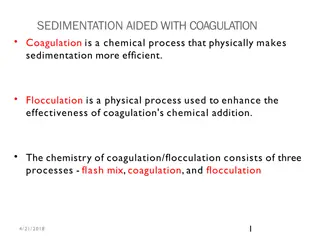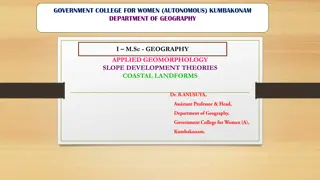Understanding Sedimentation Aided with Coagulation and Flocculation
Sedimentation aided with coagulation and flocculation is a chemical and physical process used in water treatment to efficiently remove impurities and particles. Coagulation involves adding chemicals to neutralize particles, while flocculation helps in forming larger clumps for easier removal. The en
1 views • 54 slides
Electric Properties of Colloids in Liquid Media: Charging Mechanisms and Electrokinetic Phenomena
Colloidal particles dispersed in liquid media can acquire a charge through selective adsorption of ionic species or ionization of surface groups. This leads to electrokinetic phenomena like electrophoresis, electro-osmosis, sedimentation potential, and streaming potential. The stability of colloids
2 views • 16 slides
Understanding Erythrocyte Sedimentation Rate (ESR)
Erythrocyte Sedimentation Rate (ESR) is a crucial indicator used in diagnosing and monitoring various health conditions. It measures the rate at which red blood cells settle in a test tube, providing insights into inflammation, infections, anemias, and other diseases. Factors affecting ESR include t
4 views • 24 slides
Overview of Wastewater Treatment Processes
Wastewater treatment involves primary and secondary processes to reduce suspended solids and BOD levels. Primary treatment utilizes sedimentation tanks followed by sludge thickening, while secondary treatment involves biological methods such as trickling filters. Various secondary treatment methods
0 views • 15 slides
Understanding Sedimentation: Types and Applications
Sedimentation is a physical treatment process that separates suspended solids from water using gravity. There are four types of sedimentation: discrete settling, flocculant settling, hindered settling, and compression settling. Each type describes different behaviors of solid particles as they settl
3 views • 25 slides
Understanding Centrifugation: Industrial and Laboratory Applications
Centrifugation is a procedure that utilizes centrifugal force to separate components based on density in mixtures for both industrial and laboratory purposes. This process involves the rotation of particles at high speeds to induce sedimentation. Different types of centrifuges, such as low-speed and
0 views • 18 slides
Understanding Different Types of Rocks and How They Form
Rocks are essential components of Earth's crust, consisting of various minerals held together by natural cement. They can be categorized into three groups: Igneous, Sedimentary, and Metamorphic rocks. Each group is formed differently, either through volcanic activity, sedimentation, or existing rock
3 views • 16 slides
Understanding Coastal Landforms: Formation and Characteristics
Coastal landforms are features shaped by erosion and sedimentation processes along coastlines. These landforms, including headlands, cliffs, bays, spits, salt marshes, and beaches, are predominantly influenced by factors such as wave action, longshore currents, tides, and climatic elements like wind
0 views • 35 slides
Understanding Filtration Mechanisms for Water Treatment
Filtration is a crucial process in water treatment where granular media remove solids through mechanisms like straining, sedimentation, impaction, and interception. Different types of filters, such as slow sand filters, rapid sand filters, and pressure filters, play vital roles in ensuring water qua
3 views • 10 slides
Understanding Filtration Mechanisms in Water Treatment
The filtration mechanism in water treatment involves various processes such as straining, sedimentation, impaction, and interception. Different types of filters like slow sand filters, rapid sand filters, and pressure filters play a crucial role in removing solids from water. Monitoring filtration i
1 views • 16 slides
Understanding Filtration: Process, Applications, and Mechanisms
Filtration is a process of separating solid particles or suspended matter from liquid or gas by passing it through a porous medium. This article discusses the definition of filtration, factors affecting its rate, applications in various industries, mechanisms involved, and different types of filtrat
1 views • 6 slides
Aquatic Treatment Systems for Wastewater Reclamation and Reuse
In aquatic systems, wastewater treatment involves bacterial metabolism and sedimentation, with aquatic plants playing a role in improving treatment capabilities. This article discusses the functions of aquatic plants in treatment systems and the categories of wetlands used for wastewater treatment,
1 views • 15 slides
Understanding Sedimentation in Water Treatment Processes
Sedimentation is a crucial unit operation in water treatment involving the settling of solids in liquids to form sediments. Gravity plays a key role in this process, drawing particles towards the bottom of the vessel. Differentiating between settling and sedimentation is important, with settling bei
2 views • 14 slides
Examination of Rumen Fluid and Methods of Collection
The examination of rumen fluid is crucial for diagnosing rumen diseases and for therapeutic purposes like transfaunation. Various physical and chemical characteristics are analyzed, including color, consistency, pH levels, and sedimentation activity. Abnormal findings indicate different health issue
0 views • 17 slides
Understanding Soil Erosion: Causes, Effects, and Prevention
Soil erosion, the physical removal of topsoil by agents like water, wind, and gravity, poses significant environmental challenges. Erosion affects soil quality, moisture levels, and leads to off-site issues such as sedimentation and pollution. Different types of erosion, including wind, water, and g
0 views • 21 slides
Understanding Sedimentation and ESR Test in Separation Techniques
Sedimentation is a crucial separation technique where insoluble particles settle out of a solution due to gravity. It plays a vital role in various industries like food, beverage, pharmaceutical, and water treatment. The Erythrocyte Sedimentation Rate (ESR) test, a micro-level sedimentation process
0 views • 13 slides
Understanding Mixtures: Homogeneous vs Heterogeneous and Separation Techniques
Explore the differences between homogeneous and heterogeneous mixtures, with examples like Cheerios and trail mix. Learn about mixtures like apple juice and orange juice with pulp. Discover how to separate mixtures based on their composition, whether they are homogeneous or heterogeneous, using tech
0 views • 16 slides
Understanding Sedimentation as Nonpoint Source Pollution in Aquatic Ecosystems
Explore the impact of sedimentation as a nonpoint source of pollution on aquatic ecosystems. Learn how sediment affects plant growth, disrupts the food web, and hinders the energy flow within the ecosystem. Discover why sedimentation is detrimental to life and why it is crucial to address this form
0 views • 22 slides
Exploring Marine Science and Oceanography Course Structure
This marine science and oceanography course dives into the traditional structure of understanding oceans, from Earth-building processes to human interactions. It also introduces a unique approach focusing on the oil/plastics cycle, engaging students in active learning and discussions on geoethics. T
0 views • 11 slides
Particle Size Analysis in Industrial Pharmacy: Methods and Importance
Particle size analysis is crucial in pharmacy for determining the size range and properties of particles. This lecture covers different methods of particle size analysis, such as microscopy, sieve analysis, sedimentation, and electronic determination, along with the importance of particle size in ph
0 views • 47 slides



















